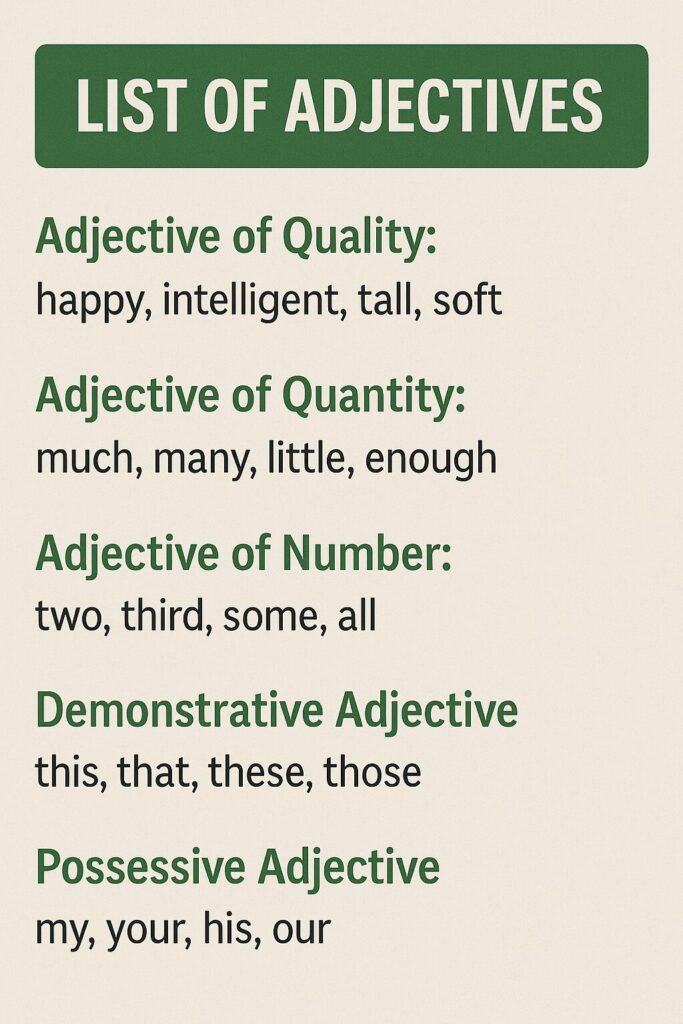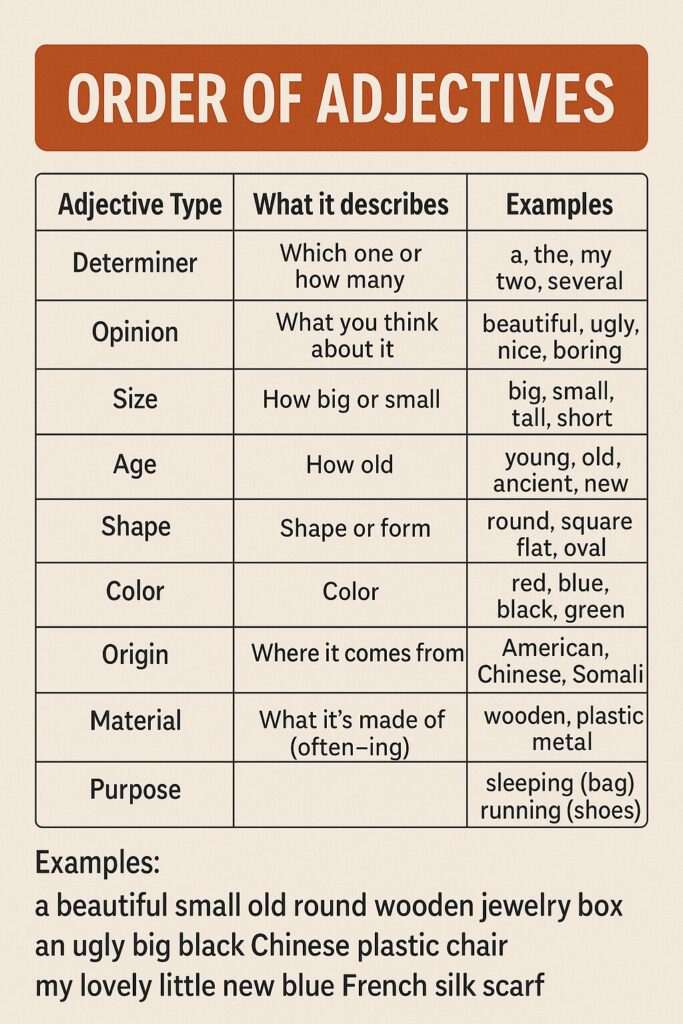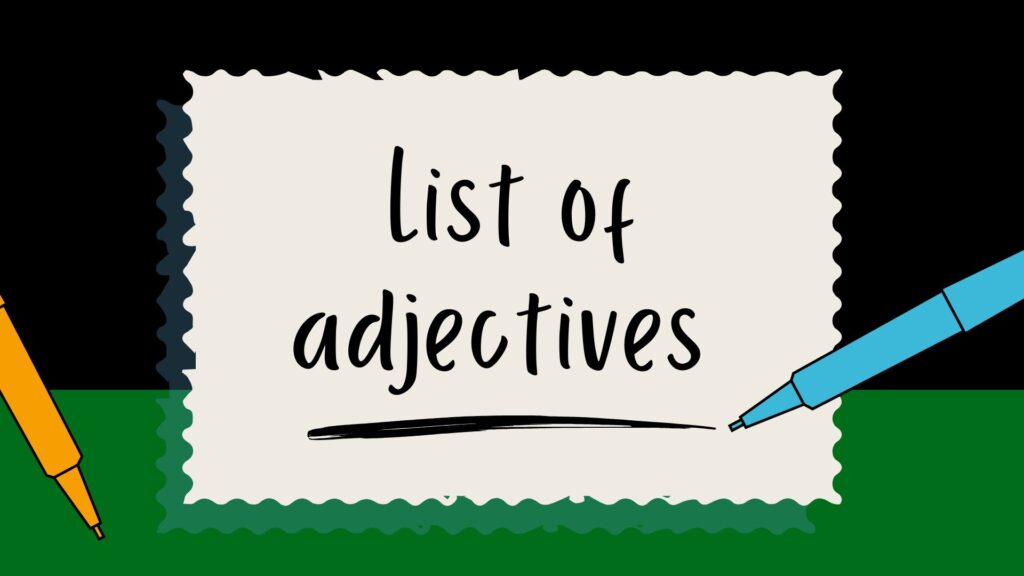Adjectives are words that describe or give more information about nouns. If you’ve ever said someone is “kind,” “tall,” or “funny,” you’ve already used adjectives! They help us explain how things look, feel, taste, sound, or behave. This article gives you a complete list of adjectives with examples, including easy explanations and practical usage. Whether you’re a student, teacher, or someone learning English as a second language, this guide is for you.
By the end of this article, you will:
• Understand the different types of adjectives
• Learn how to use adjectives in sentences
• Practice with real examples and exercises
Let’s begin our learning journey!
What Is an Adjective?
An adjective is a word that describes a noun. It gives more details about a person, place, animal, or thing.
Example:
• The happy child is playing.
• She wore a blue dress.
In both cases, the adjective gives more detail about the noun: child (happy) and dress (blue).
Why Are Adjectives Important in English?
Imagine trying to describe something without using adjectives. You might sound unclear or boring.
Without Adjectives: I saw a man.
With Adjectives: I saw a tall, old, kind man.
See the difference? Adjectives bring life to your words. They help your listener or reader picture exactly what you’re saying now we will discover about list of adjectives.
List of adjectives (with Examples)
Let’s break down adjectives into categories (list of adjectives) so they’re easier to understand and they are divided into:-
1. Descriptive Adjectives
These adjectives describe the quality of a noun.
| Adjective | Example |
| Tall | He is a tall boy |
| Beautiful | She has a beautiful smile |
| Angry | The teacher looked angry |
Descriptive adjectives also known as ( adjective of quality) help to answer the question: What kind?
They talk about:
• Appearance (tall, short, beautiful)
• Behavior (kind, rude, honest)
• Condition (broken, clean, dirty)
• Feeling (happy, sad, angry)
• Shape or size (big, round, thin)
More Examples:
• The bright sun was shining.
• It’s a delicious cake.
• They have a friendly dog.
Always think about the senses – what you see, hear, feel, taste, or smell – and you’ll naturally use descriptive adjectives.
How to Identify Adjectives of Quality
Ask the question “What kind?” about the noun.
Example 1:
The clever boy solved the puzzle.
What kind of boy? → Clever → Adjective of quality.
Example 2:
She lives in a quiet village.
What kind of village? → Quiet → Adjective of quality.
List of Common Adjectives of Quality
Here’s a list divided by category for easier learning:
Appearance:
• Handsome
• Ugly
• Cute
• Neat
• Stylish
Personality/Character:
• Polite
• Rude
• Kind
• Honest
• Brave
• Shy
Condition/Feeling:
• Sick
• Tired
• Happy
• Sad
• Angry
• Nervous
Size/Shape:
• Big
• Small
• Round
• Long
• Thin
• Wide
2. Quantitative Adjectives
Adjectives of Quantity tell us how much of something is meant or referred to. They describe amount, not number — so they’re usually used with uncountable nouns (like water, sugar, rice, money, time).
They answer the question:
“How much?”
| Adjective | Example |
| some | I have some money |
| many | she bought many apples |
| Several | They invited several guests |
How to Identify Adjectives of Quantity
Ask the question “How much?”
Example 1:
He has enough sugar.
How much sugar? → Enough → Adjective of Quantity
Example 2:
I have a little time left.
How much time? → A little → Adjective of Quantity
Examples
There is some juice in the fridge.
We don’t have any bread left.
She needs a lot of energy to finish the race.
He put little effort into the project.
You have no reason to be afraid.
Much noise can be harmful to your ears.
There isn’t much sugar left.
I saw few people at the party.
Note: Use “much” with uncountable nouns (water, sugar) and “many” with countable nouns (apples, pens).
3. Demonstrative Adjectives
Demonstrative adjectives are words used to point out specific people or things. They show which noun you’re talking about and where it is in relation to the speaker (near or far).
The four demonstrative adjectives
| Word | use for | Example |
| This | singular, near | This book is interesting. |
| That | singular, far | That car is very old. |
| These | plural, near | These apples are fresh. |
| Those | plural, near | Those stars look bright tonight. |
How to Identify Demonstrative Adjectives
Ask yourself:
Is it pointing to something?
Is it followed by a noun?
Is it telling which one or how far?
If yes, then it’s likely a demonstrative adjective, NOT a pronoun.
Example:
✅ This car is fast. (adjective – “this” describes “car”)
❌ This is fast. (pronoun – “this” stands alone)
Don’t Confuse with Demonstrative Pronouns
Let’s make it clear with a comparison
| Demonstrative adjective | Demonstrative pronoun |
| This book is mine. | This is mine. |
| I love that movie. | I love that. |
| These cookies are fresh. | These are fresh. |
| Those kids are noisy. | Those are noisy. |
4. Possessive Adjectives
A possessive adjective is a word that shows who owns something or to whom something belongs. It always comes before a noun and describes possession or ownership.
Common possessive adjectives
| Subject | possessive adjective | Examples |
| I | my | This is my phone. |
| You | your | Is this your bag? |
| He | his | His car is new. |
| She | her | Her dress is beautiful. |
| It | it’s | The dog wagged it’s tail. |
| We | our | welcome to our home |
| They | their | Their home is big. |
What Makes It a Possessive Adjective?
It comes before a noun
It answers the question: Whose?
It does not stand alone (unlike possessive pronoun.
More Examples on possessive adjective
Let’s go over examples slowly:
- My name is Ali.
(Who owns the name? I do — so we use my.)
- Your shoes are under the table.
(You own the shoes — use your.)
- His phone is ringing.
(He owns the phone — use his.)
- Her bag is pink.
(She owns the bag — use her.)
- The cat licked its paw.
(The cat owns the paw — use its.)
- Our family loves pizza.
(We own the family — use our.)
- Their house is near the park.
(They own the house — use their.)
Common Mistake: Its vs. It’s
Word Meaning Example
Its Possessive adjective (belongs to it) The dog wagged its tail.
It’s / it is raining today.
If you can replace it with “it is,” use it’s. If not, use its.
5. Interrogative Adjectives
An interrogative adjective is a question word that comes before a noun and asks a question about it.
It helps us ask which one, what kind, or how many — but must always be followed by a noun.
| Adjective | Example |
| What | Which pen do you prefer? |
| which | What book are you reading |
| whose | Whose jacket is this |
Don’t confuse with demonstrative pronoun
| Demonstrative adjective | Demonstrative pronoun |
| What book is this? | what is this? |
| which book is yours? | which is yours? |
| whose hat is this? | whose is this? |
6. Comparative and Superlative Adjectives
These compare two or more nouns.
| Form | adjective | Example |
| Positive | tall | She is tall. |
| Comparative | taller | He taller than her. |
| Superlative | tallest | John is the tallest boy in the class. |
Other Examples:
• Good → Better → Best
• Bad → Worse → Worst
• Happy → Happier → Happiest
Exercise: Describe your three best friends using comparative and superlative adjectives.
7. Color Adjectives
These describe the color of something.
| Adjective | Example |
| Red | She wore a red dress. |
| Blue | The blue sky looks amazing. |
| Green | He painted the door with green color. |
You can also use color combinations:
• A light blue shirt
• A dark green wall
8. Size and Shape Adjectives
| Adjective | Example |
| Small | It’s small room |
| Large | They live in a large house. |
| Round | She has a round face. |
| Square | The gift box was square. |
9. Age and Material Adjectives
| Adjective | Example |
| Old | This an old painting |
| Young | He is a young student. |
| Wooden | They sat on wooden bench |
| Cotton | I like cotton shirts |
Look at this image about list of adjectives

Sentence Structure with Adjectives
Adjectives usually come before the noun:
• A cold drink
• An interesting movie
Sometimes they come after certain verbs:
• She looks tired.
• He is funny.
Common verbs that link to adjectives: be, seem, appear, look, feel, sound, taste, smell
Order of Adjectives
When using more than one adjective, follow this order: Opinion → Size → Age → Shape → Color → Origin → Material → Purpose + Noun
Example: A beautiful (opinion), large (size), old (age), round (shape), red (color), Spanish (origin), wooden (material) table.

Common Adjective Mistakes
•❌ He is more taller than me.
✅ He is taller than me.
❌ She is the most smartest girl.
✅ She is the smartest girl.
❌ I have much friends.
✅ I have many friends.
Note: Don’t use “more” with -er or “most” with – est.
Practice Activity – Describe This!
Look at any object near you. Try to describe it using 5 adjectives.
Example: Phone – black, small, expensive, new, smart
Now write a full sentence:
• I have a black, small, expensive, new, smart phone.
Mini Story Using Adjectives
Let’s read a short paragraph:
It was a cold, windy morning. A young girl named Sara wore a red jacket and walked through the quiet streets. She felt nervous but excited because it was her first day at her new school. Her backpack was heavy, but her heart was full of hope.
Exercise: Highlight all the adjectives you can find. (There are 12!)
Useful Tools for Learning Adjectives
Sure! Here’s a shorter, SEO-friendly, human-toned version of your book promotion text — perfect for social media, blog intros, or product highlights.
Improve Your English Grammar with These 2 great Books
Want to speak and write English more confidently? These two top-rated grammar books on Amazon are perfect for learners and teachers alike — and they’re on limited-time discount!
1. Perfect English Grammar: The Indispensable Guide to Excellent Writing and Speaking
Price: ~$7 (51% OFF!)
This easy-to-follow guide helps you:
- Master verbs, punctuation, and sentence structure
- Improve writing and speaking skills
- Understand grammar with simple examples
Great for all levels, especially beginners!
2. English Grammar in Use by Raymond Murphy
Price: ~$26 (26% OFF!)
The world’s best-selling grammar book for intermediate learners.
- Clear explanations + practice exercises
- Ideal for self-study or classroom use
- Perfect for B1–B2 learners (and teachers too)
Why You’ll Love Them:
- Easy to understand
- Trusted by millions
- Great for exams, writing, and real-life English
- Massive discounts right now!
Start learning smarter today with these two powerful grammar books.
Let me know if you’d like this in image form or formatted for Pinterest or blog posts!
Final Tips for English Learners
• Use 3–5 adjectives daily in writing or conversation.
• Watch English shows and write down new adjectives.
• Keep a vocabulary journal with meanings and examples.
• Practice describing your day using adjectives.
Conclusion
Adjectives are essential for expressing yourself in English. From describing people to giving more detail in stories, adjectives improve both speaking and writing. This list of adjectives with examples is your first step to mastering them. Keep practicing, and you’ll soon see how much your English improves.
Also read

